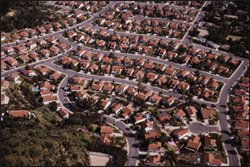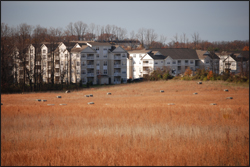Balancing Housing Affordability with Open Space Conservation
To balance residential growth with open space preservation, many rural and suburban communities are turning to conservation subdivisions. Residential lots in a conservation subdivision are grouped together on a smaller portion of the site, leaving the remaining area preserved in perpetuity for open space, recreational, or environmental purposes. Since only a small portion of the site is developed, this translates to lower infrastructure, development, and maintenance costs — savings that can be passed on to homebuyers. However, homes in conservation subdivisions are generally marketed to high-end homebuyers and are more expensive. A 2006 study looking at the economics of conservation subdivisions concluded that lots in these developments, while less expensive to build, sell faster and at a premium rate when compared to conventional subdivisions. In order to pass on the cost savings to homebuyers and to promote housing affordability in conservation subdivisions, communities can provide incentives such as density bonuses, expedited reviews, and fee waivers.
Incentives for Affordable Housing
 The town of Caledonia, Wisconsin adopted a conservation subdivision ordinance to preserve open space and to facilitate an expanded range of housing choices. The ordinance requires 40 percent of the site area in a conservation subdivision, located in an urban area with access to municipal water and sewer, to be preserved as open space. In rural areas with onsite sewer, 60 percent of site area must be preserved as open space. A maximum density bonus of 20 percent is provided for projects in which at least 15 percent of units are affordable to moderate-income households. The town of Caledonia, Wisconsin adopted a conservation subdivision ordinance to preserve open space and to facilitate an expanded range of housing choices. The ordinance requires 40 percent of the site area in a conservation subdivision, located in an urban area with access to municipal water and sewer, to be preserved as open space. In rural areas with onsite sewer, 60 percent of site area must be preserved as open space. A maximum density bonus of 20 percent is provided for projects in which at least 15 percent of units are affordable to moderate-income households.
Conservation subdivisions are a commonly used regulatory tool in the state of Maine. The town of Holden, Maine requires conservation subdivisions to provide different types of housing choices (including affordable housing), along with protecting open space and agricultural land. The town grants density bonuses if at least 10 percent of housing units developed in a conservation subdivision meet the town's affordability standards.
 The town of Bethel, Connecticut allows conservation subdivisions in its Design Conservation District overlay zone. The town's zoning code allows both single- and multifamily housing units in the overlay zones. With a minimum site area requirement of 5 acres, the code allows up to 4 units per acre, with 35 percent of site area reserved as open space. Twenty percent of the housing units must be sold or rented to households earning no more than 80 percent of the area median income. In exchange for providing the affordable units, developers may receive a density bonus of up to 50 percent. The town of Bethel, Connecticut allows conservation subdivisions in its Design Conservation District overlay zone. The town's zoning code allows both single- and multifamily housing units in the overlay zones. With a minimum site area requirement of 5 acres, the code allows up to 4 units per acre, with 35 percent of site area reserved as open space. Twenty percent of the housing units must be sold or rented to households earning no more than 80 percent of the area median income. In exchange for providing the affordable units, developers may receive a density bonus of up to 50 percent.
Conclusion
Conservation subdivisions have been around for more than a decade, but they are becoming increasingly popular with communities trying to balance the needs for housing and open space. As more and more communities take this approach to subdivision design, it's now more important than ever to include affordability provisions in conservation subdivisions to ensure a diversity of housing choices for all income levels. This can be done by adopting inclusionary housing requirements and providing regulatory incentives such as density bonuses.
Previous Article Next Article Search Archives
|

